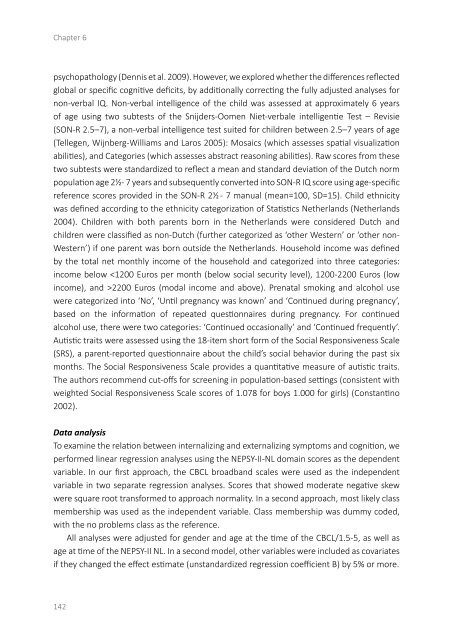On the Spectrum
2lm5UyR
2lm5UyR
Create successful ePaper yourself
Turn your PDF publications into a flip-book with our unique Google optimized e-Paper software.
Chapter 6<br />
psychopathology (Dennis et al. 2009). However, we explored whe<strong>the</strong>r <strong>the</strong> differences reflected<br />
global or specific cognitive deficits, by additionally correcting <strong>the</strong> fully adjusted analyses for<br />
non-verbal IQ. Non-verbal intelligence of <strong>the</strong> child was assessed at approximately 6 years<br />
of age using two subtests of <strong>the</strong> Snijders-Oomen Niet-verbale intelligentie Test – Revisie<br />
(SON-R 2.5–7), a non-verbal intelligence test suited for children between 2.5–7 years of age<br />
(Tellegen, Wijnberg-Williams and Laros 2005): Mosaics (which assesses spatial visualization<br />
abilities), and Categories (which assesses abstract reasoning abilities). Raw scores from <strong>the</strong>se<br />
two subtests were standardized to reflect a mean and standard deviation of <strong>the</strong> Dutch norm<br />
population age 2½ - 7 years and subsequently converted into SON-R IQ score using age-specific<br />
reference scores provided in <strong>the</strong> SON-R 2½ - 7 manual (mean=100, SD=15). Child ethnicity<br />
was defined according to <strong>the</strong> ethnicity categorization of Statistics Ne<strong>the</strong>rlands (Ne<strong>the</strong>rlands<br />
2004). Children with both parents born in <strong>the</strong> Ne<strong>the</strong>rlands were considered Dutch and<br />
children were classified as non-Dutch (fur<strong>the</strong>r categorized as ‘o<strong>the</strong>r Western’ or ‘o<strong>the</strong>r non-<br />
Western’) if one parent was born outside <strong>the</strong> Ne<strong>the</strong>rlands. Household income was defined<br />
by <strong>the</strong> total net monthly income of <strong>the</strong> household and categorized into three categories:<br />
income below 2200 Euros (modal income and above). Prenatal smoking and alcohol use<br />
were categorized into ‘No’, ‘Until pregnancy was known’ and ‘Continued during pregnancy’,<br />
based on <strong>the</strong> information of repeated questionnaires during pregnancy. For continued<br />
alcohol use, <strong>the</strong>re were two categories: ‘Continued occasionally’ and ‘Continued frequently’.<br />
Autistic traits were assessed using <strong>the</strong> 18-item short form of <strong>the</strong> Social Responsiveness Scale<br />
(SRS), a parent-reported questionnaire about <strong>the</strong> child’s social behavior during <strong>the</strong> past six<br />
months. The Social Responsiveness Scale provides a quantitative measure of autistic traits.<br />
The authors recommend cut-offs for screening in population-based settings (consistent with<br />
weighted Social Responsiveness Scale scores of 1.078 for boys 1.000 for girls) (Constantino<br />
2002).<br />
Data analysis<br />
To examine <strong>the</strong> relation between internalizing and externalizing symptoms and cognition, we<br />
performed linear regression analyses using <strong>the</strong> NEPSY-II-NL domain scores as <strong>the</strong> dependent<br />
variable. In our first approach, <strong>the</strong> CBCL broadband scales were used as <strong>the</strong> independent<br />
variable in two separate regression analyses. Scores that showed moderate negative skew<br />
were square root transformed to approach normality. In a second approach, most likely class<br />
membership was used as <strong>the</strong> independent variable. Class membership was dummy coded,<br />
with <strong>the</strong> no problems class as <strong>the</strong> reference.<br />
All analyses were adjusted for gender and age at <strong>the</strong> time of <strong>the</strong> CBCL/1.5-5, as well as<br />
age at time of <strong>the</strong> NEPSY-II NL. In a second model, o<strong>the</strong>r variables were included as covariates<br />
if <strong>the</strong>y changed <strong>the</strong> effect estimate (unstandardized regression coefficient B) by 5% or more.<br />
142


